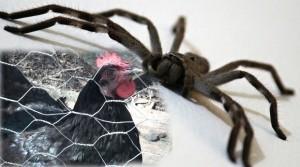Back in October, Nature published a study showing some evidence of group level selection among social tangle-web spiders. If that is in fact what the study demonstrates or strongly suggests, it would be a major finding. To date, arguments about group level selection have been dominated by evolutionary theorists and mathematicians. There is precious little empirical evidence of group level selection operating in nature, though some have argued that “religion” confers competitive advantages on human groups and is therefore an adaptation.
This is David Sloan Wilson’s controversial argument in Darwin’s Cathedral: Evolution, Religion, and the Nature of Society (2002). While Sloan Wilson’s theory is mathematically plausible, I have long doubted there was sufficient historical evidence to support it. Aside from the fact that human groups are never strictly bounded nor identity-based as “religious” in the way that the theory requires, I have always been suspicious of its teleologically-biased endorsement by evolutionary theists. It could of course be the case that humans are evolutionary outliers or freaks of nature when it comes to group level selection. Why? Because we alone have language.
This is precisely the argument that Roy Rappaport makes in Ritual and Religion in the Making of Humanity (Cambridge Studies in Social and Cultural Anthropology) (1999). While Rappaport’s theory is provocative, he may simply be describing selection for traits, such as proto-language and language, that conferred communicative advantages on individuals who have a long evolutionary history as social or group living primates. This would not be, at least initially (i.e., with the appearance of early Homo) and for a few million years thereafter, an example of group level selection. It could be such an example if some human groups evolved linguistic fluency in isolation and then used this ability to out-compete other groups. This may be what happened ~75,000 years ago with the gradual archaeological appearance of behavorial modernity and subsequent transition to what some call the Upper Paleolithic “revolution” ~50,000 years ago. If this is in fact what happened, then Rappaport’s argument for group level selection involving language — which obviously is not coeval with “religion” — becomes more compelling.
With these theoretical issues and human stakes in mind, let’s get back to the spiders. I first became aware of them, and the Nature study, while reading this article in Quanta. Aside from an interesting sidebar on what looks like artificial (i.e., human-induced) group level selection in domesticated chickens, the story was hard to follow, if not actually confusing. Upon reading it, I resolved to dissect the actual study at a later time and then present my findings here. The good news is that I have finally read the study and even better news is that someone else has done the same and already written about it.
So without further ado, I encourage interested readers to visit hbd chick for her superb analysis of the study. She is skeptical and rightly so. Why? Because while perusing the methods section of the paper, she found the probable explanation for these otherwise remarkable results: the experimenters selectively bred the spiders in a way which almost assured the outcome. Because of this assortative mating (something that would not occur in nature), we do not need to speculate about the “missing mechanism” that could account for the study results.
The lesson we can learn from hbd chick is always to peruse the methods section, especially when a study is astonishing or controversial. And speaking of chicks, the sidebar in Quanta about group level selection in egg-laying hens whetted my appetite for more. The issue, as might be expected, is not settled and not everyone thinks that domesticated poultry provides an example of group level selection. As is so often the case when it comes to this controversial theory, those arguing in its favor have ignored more parsimonious explanations. In Group Selection for “Goodness”? An Account of Chickens, a Comparison with Plants, and Implications for Humans (pdf), biologist Lonnie Aarssen connects the underlying interspecific dots and asks:
Can “goodness” evolve in humans through group-selection? It can, according to a new book, Evolution For Everyone, which claims support for this possibility from a recent research program involving artificial group-selection in chickens. Data from this study, showing increased egg production across generations, are interpreted as a product of the evolution of good, cooperative behavior among hens. In this commentary, I propose that there is a more parsimonious and more plausible interpretation for these results involving something much less noble – a system of dominance and subordination, where maximization of egg production across generations resulted from selection that increased the relative frequency of subordinate “crumb-collector” hens that passively tolerate domination by relatively few aggressive “strongpluckers.” Evidence for such dominance/suppression effects in maximizing group productivity is common in vegetation where most coexisting plants are relatively small and highly suppressed by a few larger ones, and where high productivity is interpreted by plant ecologists, not in terms of any group-selection effects, but rather in terms of traditional individual Darwinian natural selection favouring tolerance of resource deprivation, reproductive economy, and complementary resource use strategies.
It just so happens that I rented egg-laying chickens this past summer and they spent lots of plucking time in my overgrown garden, so I am able to confirm anecdotally Aarssen’s rank ordering observations. All in all, I think he has the better of this argument.


